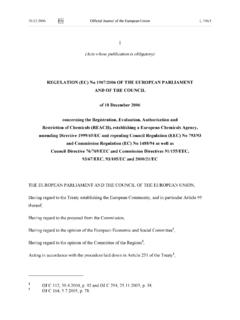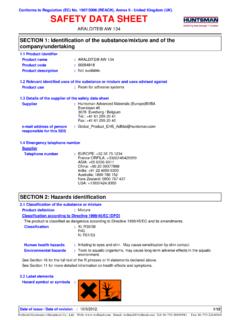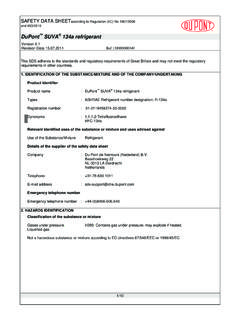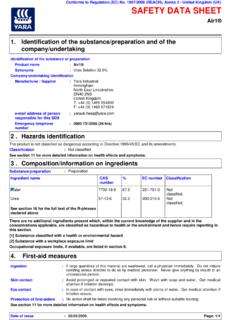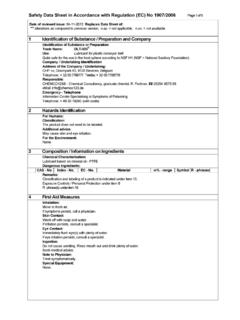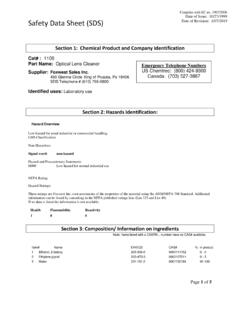Transcription of Conforms to Regulation (EC) No. 1907/2006 (REACH), Annex ...
1 NYTRO 10 XNSAFETY DATA SHEETP roduct nameNYTRO 10 XNConforms to Regulation (EC) No. 1907/2006 (REACH), Annex II - Product typeProduct descriptionInsulating Relevant identified uses of the substance or mixture and uses advised againstSECTION 1: Identification of the substance/mixture and of the company/undertakingTelephone numberHours of operation+44 (0) 1235 239 67024 hour serviceNYNAS-TECHNOL Handels-GmbHGrieskai 16A-8020 GrazAUSTRIA+43 316 73 46 00 MARPOL Annex 1 Oils2017-07-06 Date of printingDate of issue/ Date of revisionVersionDate of previous issue2017-07-062016-12-022 Distribution of substance - Industrial Formulation and (re)packing of substances and mixtures - Industrial Use in functional fluids - IndustrialUse in functional fluids - ProfessionalLubrication at high energy conditions in metal working operations - IndustrialLubrication at high energy conditions in metal working operations - ProfessionalIdentified Details of the supplier of the safety data sheete-mail address of person responsible for this SDSN ational Emergency telephone numberNational advisory body/Poison CentreHead office.
2 Nynas Box 10700SE-121 29 StockholmSWEDEN+46 8 602 12 00 (Office hours 8 am - pm product must not be used in applications other than those recommended in Section 1, without first seeking the advice of the advised againstReason+43 1 406 43 43 (Austrian Poison Control Centre)Date of issue/Date of revision:2017-07-06 Date of previous issue:2016-12-02 Version:21/36 NYTRO 10 XNConforms to Regulation (EC) No. 1907/2006 (REACH), Annex IISECTION 2: Hazards Classification of the substance or mixtureProduct Label elementsHazard pictogramsSignal wordHazard statementsPreventionPrecautionary statementsResponseStorageDisposalDangerH 304 - May be fatal if swallowed and enters - Harmful to aquatic life with long lasting + P310 + P331 - IF SWALLOWED: Immediately call a POISON CENTER or physician.)
3 Do NOT induce - Avoid release to the - Store locked - Dispose of contents and container in accordance with all local, regional,national and international label elementsNot Other hazardsSubstance meets the criteria for PBT according to Regulation (EC) , Annex XIIINot meets the criteria for vPvB according to Regulation (EC) , Annex XIIINot XVII - Restrictions on the manufacture, placing on the market and use of certain dangerous substances, mixtures and articlesNot according to Regulation (EC) No. 1272/2008 [CLP/GHS]Asp. Tox. 1, H304 Aquatic Chronic 3, H412 The product is classified as hazardous according to Regulation (EC) 1272/2008 as Section 11 for more detailed information on health effects and Section 16 for the full text of the H statements declared nameSECTION 3: Composition/information on ingredients%TypeRegulation (EC) No.
4 1272/2008 [CLP] MixturesMixtureDate of issue/Date of revision:2017-07-06 Date of previous issue:2016-12-02 Version:22/36 NYTRO 10 XNConforms to Regulation (EC) No. 1907/2006 (REACH), Annex IISECTION 3: Composition/information on ingredientsOccupational exposure limits, if available, are listed in Section (petroleum),hydrotreated light naphthenicREACH #:01-2119480375-34EC: 265-156-6 CAS: 64742-53-6 Index: 649-466-00-2>99 Asp. Tox. 1, H304[1]2,6-di-tert-butyl-p-cresolREACH #:01-2119555270-46EC: 204-881-4 CAS: 128-37-0< Acute 1, H400 (M=1)Aquatic Chronic 1, H410 (M=1)[1] [2]See Section 16 for the full text of the H statements declared above.[1] Substance classified with a health or environmental hazard[2] Substance with a workplace exposure limit[3] Substance meets the criteria for PBT according to Regulation (EC) No.
5 1907/2006 , Annex XIII[4] Substance meets the criteria for vPvB according to Regulation (EC) No. 1907/2006 , Annex XIII[5] Substance of equivalent concern[6] Additional disclosure due to company policyTypeAnnex I Nota L applies to the base oil(s) in this product. Nota L - The classification as a carcinogen need not apply if it can be shown that the substance contains less than 3 % DMSO extract as measured by IP are no additional ingredients present which, within the current knowledge of the supplier and in the concentrations applicable, are classified as hazardous to health or the environment, are PBTs or vPvBs or have been assigned a workplace exposure limit and hence require reporting in this assume that aspiration has occurred. Do not induce vomiting. Can enter lungs and cause damage.
6 If vomiting occurs, the head should be kept low so that vomit does not enter the lungs. Seek professional medical attention or send the casualty to a hospital. Do not wait for symptoms to develop. Never give anything by mouth to an unconscious person. If unconscious, place in recovery position and get medical attention immediately. Maintain an open tight clothing such as a collar, tie, belt or contactRinse cautiously with water for several minutes. Remove contact lenses, if present and easy to do. Continue rinsing. If irritation, blurred vision or swelling occurs and persists, obtain medical advice from a with soap and water. Remove contaminated clothing and shoes. Handle with care and dispose of in a safe manner. Seek medical attention if skin irritation,swelling or redness develops and persists.
7 Accidental high pressure injection through the skin requires immediate medical attention. Do not wait for symptoms to Description of first aid measuresIf breathing is difficult, remove victim to fresh air and keep at rest in a position comfortable for breathing. If casualty is unconscious and: If not breathing, if breathing is irregular or if respiratory arrest occurs, provide artificial respiration or oxygen by trained personnel. Get medical attention if adverse health effects persist or are severe. Maintain an open contactProtection of first-aidersNo action shall be taken involving any personal risk or without suitable training. It may be dangerous to the person providing aid to give mouth-to-mouth resuscitation. Before attempting to rescue casualties, isolate area from all potential sources of ignition including disconnecting electrical supply.
8 Ensure adequate ventilation and check that a safe, breathable atmosphere is present before entry into confined 4: First aid measuresDate of issue/Date of revision:2017-07-06 Date of previous issue:2016-12-02 Version:23/36 NYTRO 10 XNConforms to Regulation (EC) No. 1907/2006 (REACH), Annex IISECTION 4: First aid measuresNotes to physicianDue to low viscosity there is a risk of aspiration if the product enters the lungs. Treat Most important symptoms and effects, both acute and delayedPotential acute health effectsInhalationInhalation of oil mist or vapours at elevated temperatures may cause respiratory be fatal if swallowed and enters contactNo known significant effects or critical contact may cause redness and transient Indication of any immediate medical attention and special treatment neededAlways assume that aspiration has isolate the scene by removing all persons from the vicinity of the incident if there is a fire.
9 No action shall be taken involving any personal risk or without suitable thermal decomposition productsHazards from the substance or mixtureIncomplete combustion is likely to give rise to a complex mixture of airborne solid and liquid particulates, gases, including carbon monoxide, H2S, SOx (sulfur oxides) or sulfuric acid and unidentified organic and inorganic a fire or if heated, a pressure increase will occur and the container may burst. This substance will float and can be reignited on surface water. Fire water contaminated with this material must be contained and prevented from being discharged to any waterway, sewer or should wear appropriate protective equipment and self-contained breathing apparatus (SCBA) with a full face-piece operated in positive pressure mode. Clothing for fire-fighters (including helmets, protective boots and gloves)conforming to European standard EN 469 will provide a basic level of protection for chemical protective equipment for fire-fightersUse dry chemical, CO , water spray (fog) or Extinguishing mediaDo not use direct water jets on the burning product; they could cause splattering and spread the fire.
10 Simultaneous use of foam and water on the same surface is to be avoided as water destroys the extinguishing mediaUnsuitable extinguishing mediaSECTION 5: Firefighting Special hazards arising from the substance or Advice for firefightersSpecial precautions for fire-fightersSECTION 6: Accidental release Personal precautions, protective equipment and emergency proceduresFor non-emergency personnelAvoid breathing vapour or mist. Keep non-involved personnel away from the area of spillage. Alert emergency personnel. Except in case of small spillages, the feasibility of any actions should always be assessed and advised, if possible, by a trained,competent person in charge of managing the emergency. Stop leak if safe to do direct contact with the product. Stay upwind/keep distance from source.
